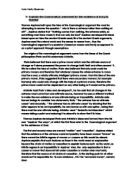Explain the cosmological argument for the existence of God from Aquinas and Copleston (25 marks)
Explain the cosmological argument for the existence of God from Aquinas and Copleston (25 marks)
Plan
- ‘Cosmo’ means universe
- Cause and effect
- Thomas Aquinas- third century, his three ways
- Frederick Copleston radio show in 1940s used his 4 steps
- Aquinas first way- Motion, potential to actual
- Second way- Cause and effect- first cause
- Third way- contingency- world had a beginning, no infinite regress, had to be caused by necessary being
- Copleston- 4 steps- contingency
- God contains explanation for existence in himself
The cosmological argument is an a posteriori argument for the existence of God. It was based on the observations of cause and effect that we see in the world. Thomas Aquinas, a 13th Century philosopher used his 3 ways argue for the cosmological argument. His three ways were motion, causation and contingency. Frederick Copleston developed and explained his view of the cosmological argument in a radio broadcast in the 1940s by using 4 steps.








